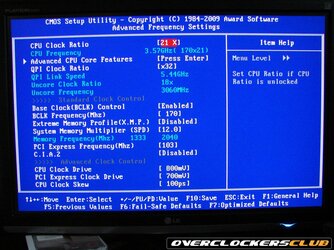- Joined
- Apr 10, 2001
So I'm coming from a 4 year old AMD system to this new i5 system I've built, and whoa are things different. I need some help with overclocking this rig.
I'm not looking for the all out fastest settings I can use, but something good for 24/7 OC.
I'm also not sure about turning on or off the power saving features that allow CPU clock and voltage throttling. I believe the motherboard has some of these features as well as Windows 7 itself.
The components I used are:
i5 750 CPU
Gigabyte P55 UD3R mainboard
Megahalems CPU Cooler with 2 x 120mm fans in push pull config
OCZ Platinum DDR 1333 memory (2 x 2GB sticks)
MSI Radeon 4670 Graphics
Corsair 650TX PSU
6 x SATA HDD (2 x Raid1, 2 x Raid 1, 2 x Raid0)
OS is Windows 7 Ultimate 64-bit
I've tried to find some type of guide, but so far I've had no luck.
The Bios has a MIT settings area for overclocking, but there are so many settings I'm not sure what does what.
I'm unfamiliar with:
QPI Clock Ratio
QPI Link Speed
Uncore Clock Ratio
Uncore Frequency
I understand that the CPU Clock Ratio and BCLK Frequency determine the CPU speed (20 x 133 = 2.66Ghz default speed of the i5 750).
I understand that the System Memory Multiplier (SPD) times the BLCK Frequency determines the memory speed (10 x 133 = 1333 default speed of the RAM).
I'm unfamiliar with:
CPU Clock Drive
PCI Express Clock Drive
CPU Clock Skew
Below is a screen shot of the MIT section of the BIOS where OC settings are made...this is not mine, this is from another website that did a review of the mainboard.

I'm not looking for the all out fastest settings I can use, but something good for 24/7 OC.
I'm also not sure about turning on or off the power saving features that allow CPU clock and voltage throttling. I believe the motherboard has some of these features as well as Windows 7 itself.
The components I used are:
i5 750 CPU
Gigabyte P55 UD3R mainboard
Megahalems CPU Cooler with 2 x 120mm fans in push pull config
OCZ Platinum DDR 1333 memory (2 x 2GB sticks)
MSI Radeon 4670 Graphics
Corsair 650TX PSU
6 x SATA HDD (2 x Raid1, 2 x Raid 1, 2 x Raid0)
OS is Windows 7 Ultimate 64-bit
I've tried to find some type of guide, but so far I've had no luck.
The Bios has a MIT settings area for overclocking, but there are so many settings I'm not sure what does what.
I'm unfamiliar with:
QPI Clock Ratio
QPI Link Speed
Uncore Clock Ratio
Uncore Frequency
I understand that the CPU Clock Ratio and BCLK Frequency determine the CPU speed (20 x 133 = 2.66Ghz default speed of the i5 750).
I understand that the System Memory Multiplier (SPD) times the BLCK Frequency determines the memory speed (10 x 133 = 1333 default speed of the RAM).
I'm unfamiliar with:
CPU Clock Drive
PCI Express Clock Drive
CPU Clock Skew
Below is a screen shot of the MIT section of the BIOS where OC settings are made...this is not mine, this is from another website that did a review of the mainboard.

Last edited: